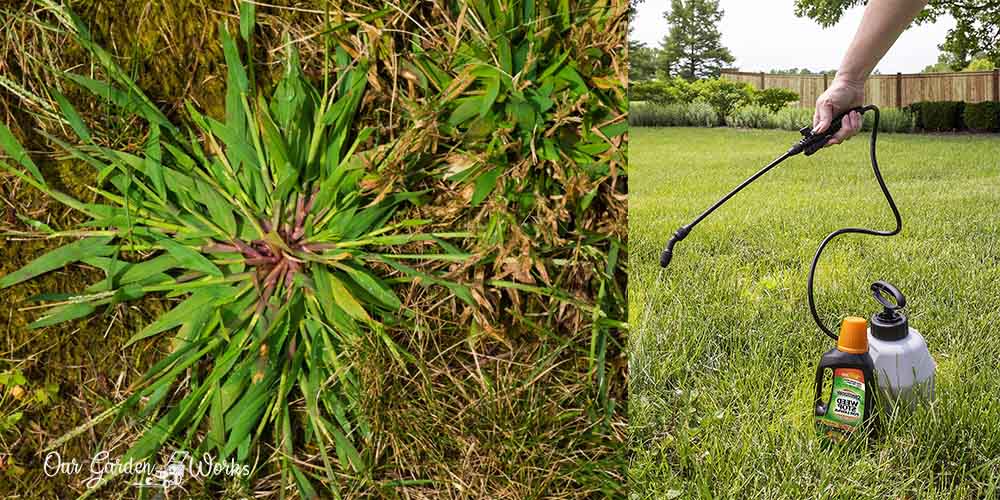Among the toughest weeds, crabgrass is probably among the list, along with dandelions. It grows horizontally in the ground that makes it survive the sharp blades of a lawnmower and the high foot traffic pathways.
Crabgrass can also grow almost anywhere, starting from the field up to the small cracks in pavements.
Gardeners are using two approaches to control the crabgrass in lawns and fields. The first method uses a pre-emergent herbicide that prevents the crabgrass seeds from germinating. The second approach is to kill the matured crabgrass weeds and curb their flower production and prevent the spread of weed seeds.
If you’re spending some time caring for your lawn this season, here are some of the features that you should check in selecting the best crabgrass killer:
- Is it safe to use it around edible plants? Just like pesticides, herbicides can be toxic when ingested by humans. Check the toxicity level and the residual effect of the crabgrass killer you are about to buy.
- How frequently do you have to apply it on your lawn? Some herbicides only work the more you apply them on your lawn.
- Does it kill other grass? The most crucial thing to check in a herbicide is what type of plants it can kill.
10 Best Crabgrass Killer – [Reviews & Top Picks in 2023]
In this post, we will give you the best crabgrass killer that gardeners swear by. Most of the products listed in this post contain quinclorac that is effective crabgrass control.
Quinclorac is a selective herbicide that controls specific weed types found on rice fields and lawns like crabgrass without killing other plants.
1. Primesource Quinclorac Liquid Crabgrass Killer
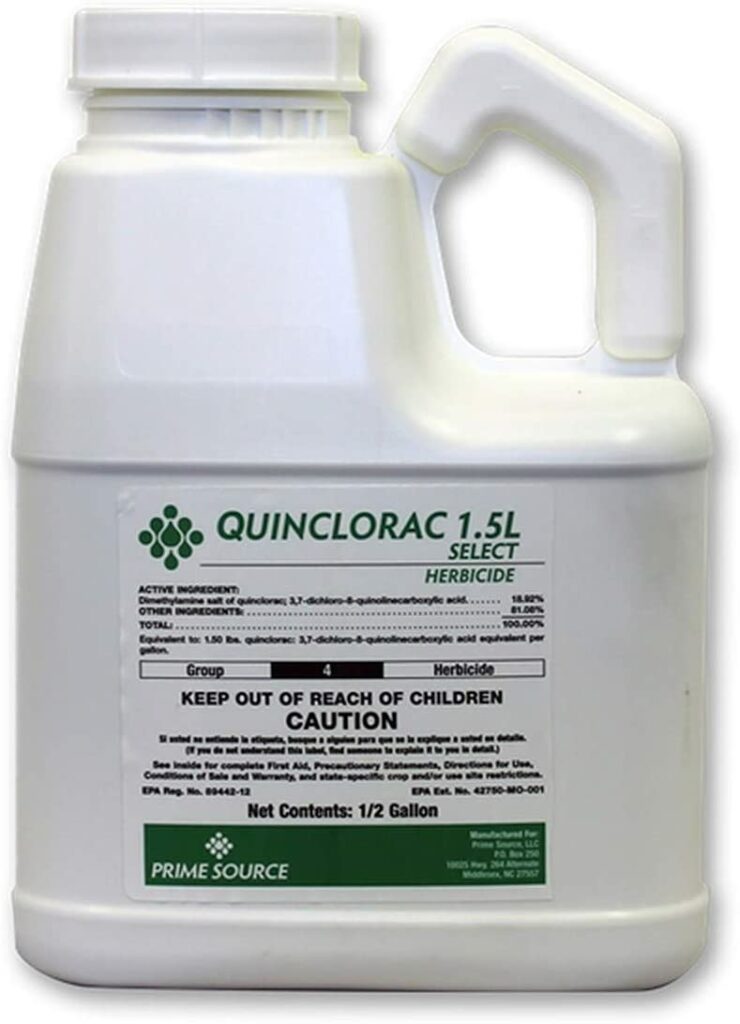
Primesource Quinclorac Liquid Crabgrass Killer is a post-emergent herbicide wherein it controls the existing mature crabgrass in your field. It is suitable for both residential and commercial use.
This crabgrass killer can control common broadleaf and grass weeds such as:
- Crabgrass (large & smooth)
- Foxtail (giant, green & yellow)
- Kikuyu grass
- Signalgrass (broadleaf)
- Torpedo grass
- Bindweed (field)
- Clover (hop, red & white)
- Daisy (English)
- Dandelion
- Dollarweed
- Geranium (Carolina)
- Morning glory spp.
- Speedwell (common, slender & thymeleaf)
This herbicide contains 18.92% Quinclorac. You must apply it a week before the seedling stage of crabgrass or 28 days since you first saw crabgrass growth in your lawn. It works best when mixed with methylated seed oil.
The manufacturer claims that you can mix it with other herbicides. However, you must carefully check their labels for the mixing directions and order.
Always remember that herbicides are highly toxic, so you must wear protective equipment in mixing them with other substances or when using them on your lawn.
The best feature of this herbicide is it can protect your lawn from crabgrass for three months. It also has a concentrated formula. So, a bottle can go a long way.
However, some gardeners experience discoloration in their lawns after using this herbicide. It’s best to do a patch test on a small portion of your lawn to see its effect on your grass.
Reminder: It is not advisable to mow your lawn before and after Primesource Quinclorac Liquid Crabgrass Killer. If it does not curb the crabgrass growth in your yard, do not reapply and use another brand instead.
Pros
- With Quinclorac that selectively kills crabgrass weeds
- Controls weeds for up to 90 days
- Highly-concentrated
- Controls a variety of persistent weeds
Cons
- May cause discoloration in some cases
- May fail to control some biotypes of large and smooth crabgrass in California
2. Scotts Halts Crabgrass Preventer
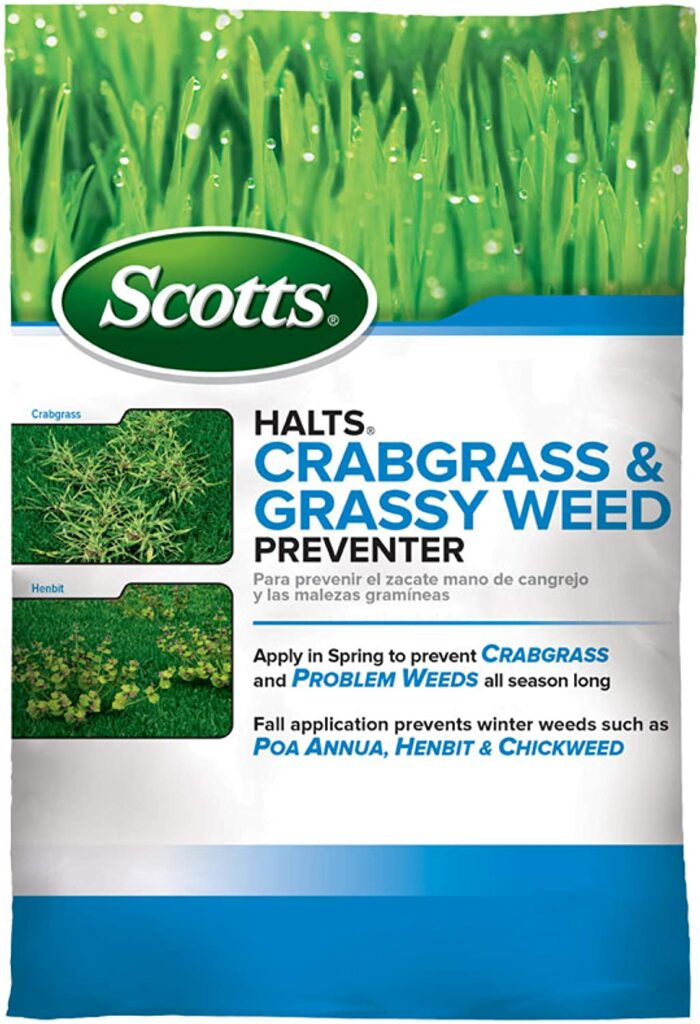
Next on our list is an affordable crabgrass killer from Scotts.
Scotts Halts Crabgrass Preventer is a pre-emergent herbicide where it controls the seeds of crabgrass from germinating. Its recommended application is in early spring, wherein most dormant seeds and plants start to grow again. You may also apply it on your lawn during fall if you want to control the following weeds:
- Poa annua
- Henbit
- Chickweed
The 5,000 q. ft. coverage of this herbicide is big enough to cover hectares of your lawn. The crucial factor for this herbicide to take effect is to apply it at the right time. Otherwise, it won’t stop the crabgrass from germinating in spring.
The ideal temperature for crabgrass to germinate is 59F to 65F. So, avoid applying this herbicide as soon as the snow melts, and let the soil warm up a bit before you spread this herbicide on your lawn.
Bald spots will get warm faster, so you should apply crabgrass killer on them earlier than the rest of the yard.
The only caution you need to look out for is that it contains pendimethalin that can affect the seeding of the grass you want to grow on your lawn. Refrain from moving the soil after applying this herbicide for best results. It’s also available in selected states such as:
- Alabama
- Arkansas
- Arizona
- Florida
- Georgia
- Kansas
- Louisiana
- Missouri
- Mississippi
- North Carolina
- New Mexico
- Oklahoma
- South Carolina
- Tennessee
- Texas
- Virginia
The manufacturer also recommends only applying it twice a year with a two-month interval for best results. Overapplication of herbicides may lead to soil damage and keep your desired grass seeds from germinating.
Pros
- Affordable crabgrass killer
- Efficient in controlling crabgrass when applied at the right soil temperature
- Works best on controlling lawn moss in the fall
- Season-long broadleaf and grassy weeds control
- Applicable in any weather (rain, snow, or freezing)
Cons
- Has pendimethalin and cannot be used when seeding your lawn
- It will not kill crabgrass that is present in the yard during the time of application.
- Not registered for use around ornamentals
- Any actions that break the barrier in the soil, such as digging or aerating, will diminish the effectiveness.
3. BASF Drive XLR8 Crabgrass Herbicide
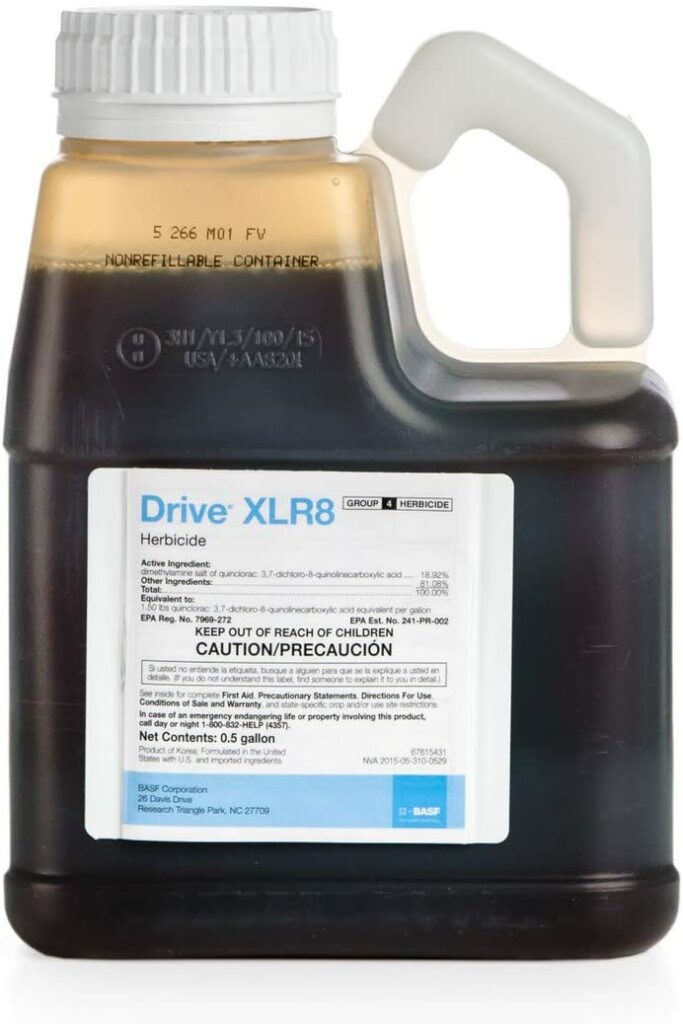
Moving away from the mainstream brands, you have BASF Drive XLR8 Crabgrass Herbicide. It is a post-emergent herbicide that contains 18.92% of Quinclorac. You can use it in controlling the following weeds:
- Barnyard grass
- Bindweed
- Crabgrass (large & smooth)
- Clover
- Dandelion
- Daisy
- Dollar weed
- Foxtail
- Kikuyu grass
- Signal grass
- Speedwell
- Torpedo grass
It only takes 1.5 oz. of this herbicide to cover a 1000-square-foot yard. So, a half-gallon can provide you with 42,000 square feet of crabgrass control. It is safe to use if the grass on your yard is any of the following:
- Bermuda grass
- Kentucky bluegrass
- Buffalo grass
- Fescue
- Ryegrass
- Zoysiagrass
What most gardeners love about this herbicide is it controls the crabgrass in one application. Results usually show two days after the application, and all the crabgrass in your lawn will be gone in seven days.
However, this herbicide is not suitable for crabgrass control if you have:
- St. Augustine
- Centipede
- Bahiagrass
- Bentgrass
- Dichondra
- Fine fescue
The manufacturer claims that the crabgrass begins to die within 24 to 48 hours, then turns brown in about a week.
Since it is a chemical, make sure to wear long pants, shoes, and waterproof gloves upon application. Wash your clothes immediately after use. It’s a little pricey than other brands, but you’ll surely get your money’s worth.
Pros
- A half-gallon allows you to treat a full acre of crabgrass.
- Dries in less than an hour
- Controls mature crabgrass with four tillers or more.
- Controls the tough-to-control weeds like dandelion
- Works as advertised
Cons
- Pricey
- Weird smell
- Not for use to control horseweed in California
- The residual effect can be as long as 45 days at the maximum amount of application.
4. Syngenta Tenacity Herbicide
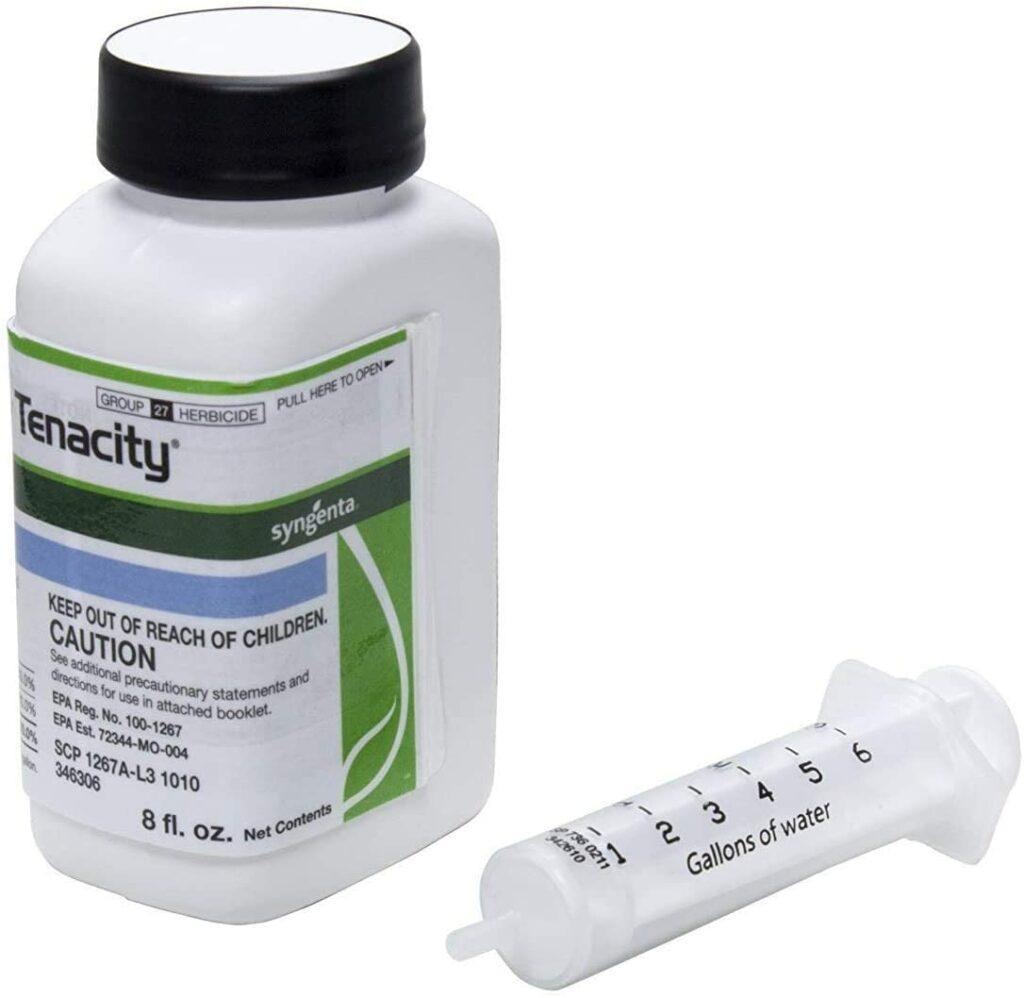
The size of Syngenta Tenacity Herbicide can be deceiving, but it is among the toughest crabgrass killers in the market. It is both a pre-emergent and post-emergent herbicide for more than 46 broadleaf weed and grass species. So, it both prevents the weed seeds from germination and kills the existing adult crabgrass in your yard.
Aside from crabgrass, you can use it to control the following weeds:
- Ground ivy
- Yellow foxtail
- Yellow nutsedge
- Bentgrass
- Barnyardgrass
- Creeping Bentgrass
- Annual Bluegrass
- Buckhorn Plantain
- Buttercup
- Carpetweed
- Common Chickweed
- Mouse-ear Chickweed
- Large Hop Clover
- White Clover
- Large Crabgrass
- Smooth Crabgrass
- Southern Crabgrass
- Ground ivy
- Yellow foxtail
- Yellow nutsedge
- Nimblewill
Its active ingredient is Mesotrione and Tenacity is one of the two companies that solely offer this herbicide today. This herbicide is safe for use before seeding on the following types of grass:
- Kentucky bluegrass
- Tall fescue
- Perennial ryegrass
- Centipedegrass
Tenacity is highly concentrated. It may look like it is in a small bottle, but a teaspoon can already make two gallons of herbicide for your lawn. The manufacturer recommends mixing the diluted two gallons of this herbicide with a non-ionic surfactant for best results.
What makes it unique, aside from being both pre-emergent and post-emergent herbicide, is it’s made of organic compounds. Therefore, this herbicide is less toxic around your kids and pets. Just make sure that you let it run dry before allowing anyone to set foot in your yard.
Some gardeners find the syringe that comes with the product a bit difficult to use. However, as per performance, many gardeners are satisfied and swear by this crabgrass killer.
Pros
- Highly-concentrated
- Controls weed seeds from germinating and kills current mature crabgrass
- Controls weeds at seeding, reducing weed competition
- Provides post-emergent control of tough-to-control weeds
- Can go hand-in-hand with seeding on the same day of application
- It is safe and non-toxic for children and pets once it has dried up
Cons
- A repeat application is required after two to three weeks for improved post-emergent weed control.
- The syringe is hard to use for other gardeners.
- It takes a week to see the results compared to 2-3 days with other herbicides.
5. BioAdvanced All-in-One Lawn Weed and Crabgrass Killer
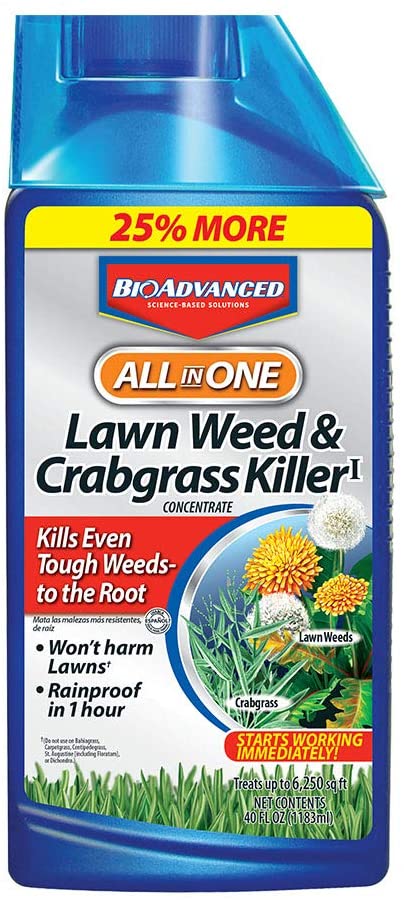
If you’re a gardener that’s into a brand familiar to you, BioAdvanced would be a good option for you.
BioAdvanced All-in-One Lawn Weed and Crabgrass Killer is a pre-emergent herbicide that can control over 200 species of lawn weeds. These includes:
- Black Medic
- Broadleaf Plantain
- Broadleaf Weeds
- Buttonweed
- Common Chickweed
- Creeping Charlie
- Dandelion
- Dollarweed
- English Daisy
- Henbit
- Lambsquarters
- Lespedeza
- Oxalis
- Pennywort
- Red Clover
- Spotted Spurge
- Thistle
- Wild Mustard
This herbicide contains 1.61% Quinclorac and 0.45% Dicamba which selectively kills weeds and does not harm your lawn grass. It has a residual effect and does not wash out when it rains one hour after application.
The manufacturer recommends applying this herbicide to your lawn in temperatures between 50F and 90F. Application in humid weather conditions that go beyond 90F can damage your yard.
You can safely use this if you have:
- Bermudagrass
- Buffalo grass
- Kentucky grass
- Bluegrass
- Ryegrass
- Fescue
- Zoysia
- Bentgrass
Many gardeners love it for its efficiency in dealing with stubborn weeds. It works efficiently as long as you target the weeds mentioned in its labels. However, to set your expectation, it doesn’t instantly kill the weeds. It will take about a week or two to see dead crabgrass in your yard.
Incorrect application rate and temperature will cause damages on Bahia, Bermuda, Carpet, and St. Augustine grass. Other than that, it is a brand worth trying, especially if it usually rains in your region.
Pros
- Cost-effective
- Kill even the toughest weeds to the root
- Rainproof for 1 hour
- 40 oz bonus concentrate
- Safe to use on most lawns in a variety of regions
- Pet-safe when mixed properly
Cons
- Slight mistakes on temperature and application rate can damage Bahia, Bermuda, Carpet, and St. Augustine grass
- Additional sprays might be necessary per season, depending on the region
6. Spectracide Weed Stop For Lawns Plus Crabgrass Killer Concentrate
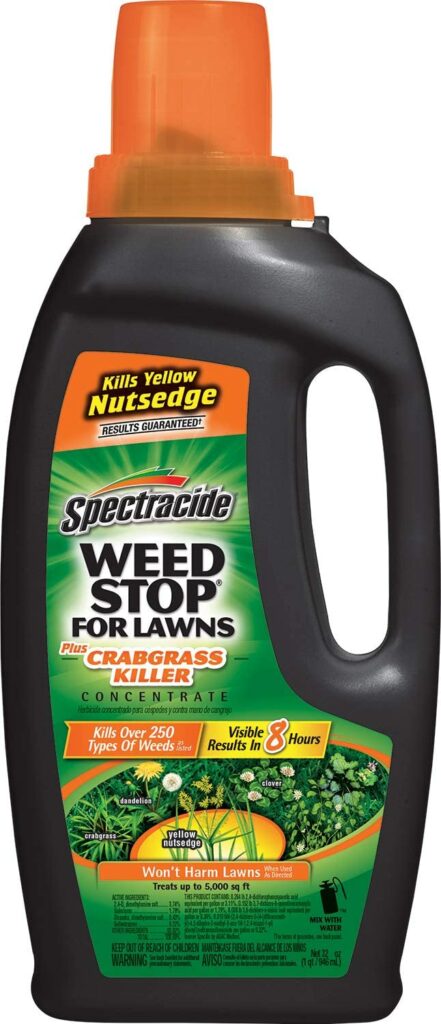
Spectracide is another well-known crabgrass killer aside from BioAdvanced. It is a post-emergent herbicide that kills about 470 types of weeds. Some of the persistent weeds that it controls are:
- Crabgrass
- Dandelion
- Chickweed
- Clover
- Foxtail
- Yellow nutsedge
For crabgrass control, apply this herbicide as soon as the crabgrass starts to emerge until its six-leaf stage or before it is 3 to 4 inches tall. Use two applications at the same rate in a 14-day interval serious and dense invasion of crabgrass.
This herbicide contains:
- 2,4-D, dimethylamine salt (3.74%)
- Quinclorac (1.79%)
- Dicamba, dimethylamine salt (0.43%)
- Sulfentrazone (0.22%)
The manufacturer is particular that you only need to apply this herbicide on the following turfgrass:
- Kentucky bluegrass
- Perennial ryegrass
- Fescue spp., including tall, red, and fine leaf fescues.
- Zoysiagrass
- Bermudagrass
- Buffalograss
If you have zoysiagrass, do not apply this herbicide as soon as it emerges from dormancy to prevent lawn damage. As for bermudagrass, application in temperatures beyond 90F will also do more damage than good.
The only downside that the manufacturer acknowledges is the temporary yellowing of your bermudagrass. However, it will eventually go back to its usual lush green color after a few weeks.
Pros
- Visible results within a few hours
- Treats up to 5,000 sq. ft. lawn
- Rain-safe within 3 hours after application
- Kills by contact
- Good packaging
Cons
- The application area should be 5 feet away from the vegetable to prevent damage.
- Not safe for ornamental plants, including flowers, trees, shrubs, hedges, woody ornamentals, groundcovers established in landscape plantings, and other non-target plants.
- Damaged yards containing St. Augustinegrass, bahiagrass, centipedegrass, or carpetgrass.
- Toxic to fish and aquatic invertebrates.
- Restricted in some state
- Temporary yellowing on bermudagrass
7. Compare-N-Save Weed and Grass Killer Concentrate
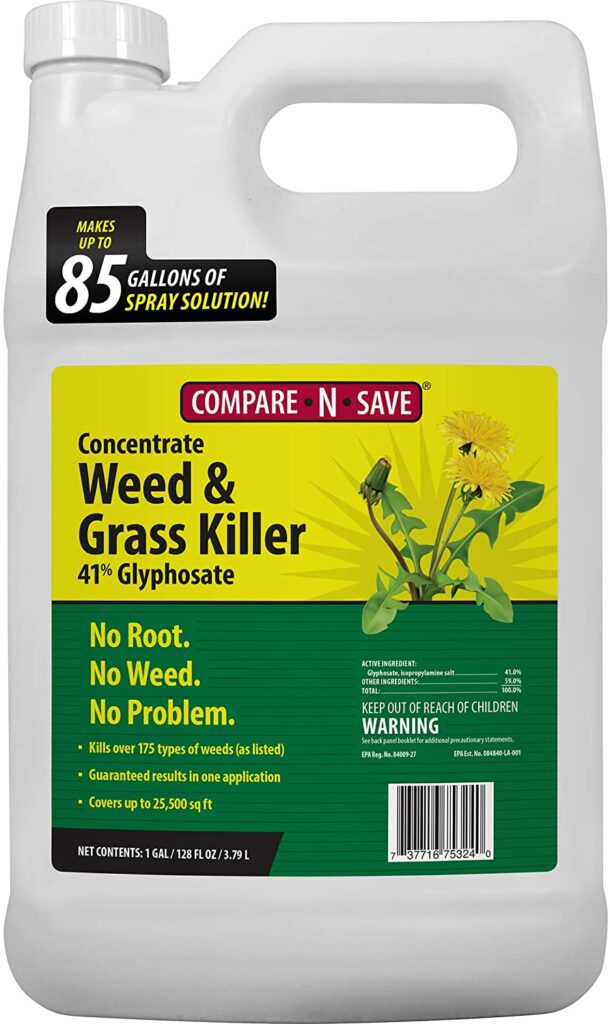
Compare-N-Save Herbicide is a post-emergent herbicide that contains glyphosate. It is among the few brands that use the compound glyphosate that inhibits the growth of the following:
- Weeds
- Grasses
- Vines
- Bush
- Stump
This herbicide is rainproof for two hours after application. The results may show within 2 to 4 days. It is a concentrate, so a little goes a long way.
When diluted, it can cover up to 25,000 square feet of yard. Unlike other herbicides, it kills all green plants, including lawn grass, so it is not recommended for spot spraying.
The glyphosate in this herbicide is at 41%. It has no residual activity, which means it can’t prevent weed seeds from germinating for the upcoming days. Re-application may be needed to address new crabgrass growth in the affected area of your property.
This herbicide is a perfect solution for getting rid of crabgrass in pathways or parts of your property where you don’t want to see any greens popping out. It also costs a fraction more than its competitors, which most gardeners love about this product.
Be mindful that this herbicide contains the highest concentration of glyphosate in the market and kills through foliar contact. It is not selective, so be extra cautious in using it in your yard.
Pros
- More affordable than other herbicides with glyphosate
- Kill any weeds it touches
- Multipurpose(weed killer and stump killer)
- Kill poison oak and star thistle
- Rainproof for 2 hours
Cons
- Can cause eye and skin irritation (use with caution)
- Do not selectively kill weeds and not recommend spot-spraying in yards.
8. Roundup Weed & Grass Killer Super Concentrate
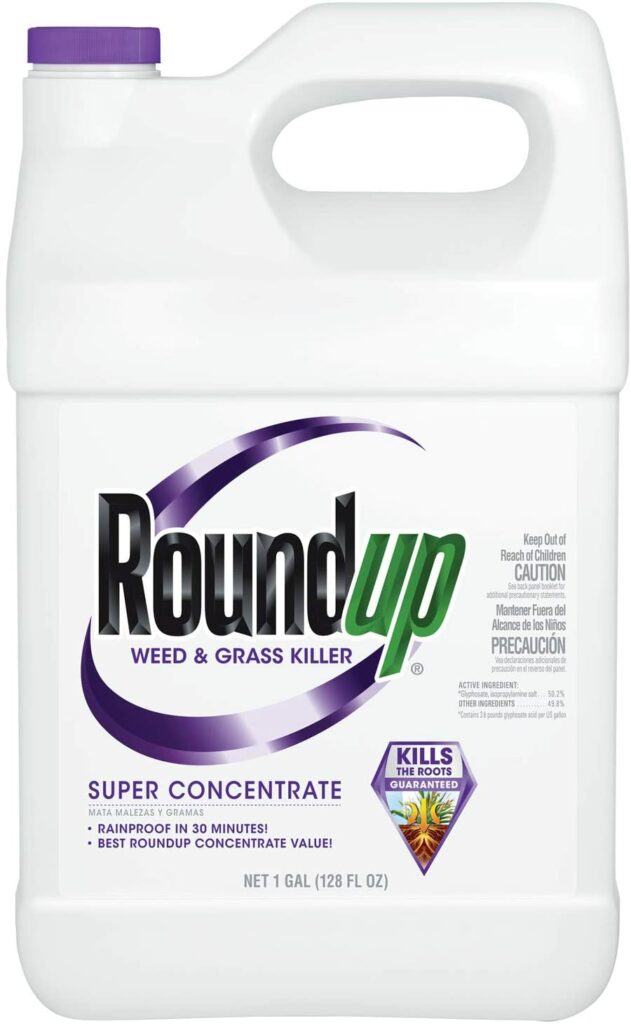
If you’ve been searching for crabgrass killer online, RoundUp is probably the first one you’ll find. It is a non-selective post-emergent herbicide that can kill stubborn crabgrass in the following areas:
- Around flowers, shrubs, and trees
- Patios, walkways, driveways, gravel areas, and mulch beds
- Along fences, edging, and foundations.
- Large areas like lawn replacements or garden plot preparation
This herbicide is rainproof for 30 minutes, and weeds usually start to wilt in 2 to 4 days. It contains 50.2% of glyphosate, which inhibits the growth enzymes in weeds starting from the foliage to the roots. It kills any plant that it touches, so make sure to handle it with caution.
Most gardeners love RoundUp for being true to its claims in controlling tough weeds. It also has a long shelf-life of 8 years, and a 35-ounce bottle can make about 32 gallons of diluted herbicide. It is even mentioned in several agricultural articles due to its good reputation in weed control.
The only thing that concerns some gardeners about RoundUp is its market price. It’s quite pricey, but its value is worth the price. The reputation of the manufacturer is also a consideration for some gardeners.
Pros
- Rainproof for 30 minutes after application
- Simple and easy to use
- Ideal crabgrass killer for large areas
- Highly-concentrated
- It attacks the entire plant above and below the soil
Cons
- The 50.2-percent Glyphosate level requires extra caution when used.
- Not registered for sale or use in New York
9. Ortho Weed B Gon Plus Crabgrass Control Concentrate
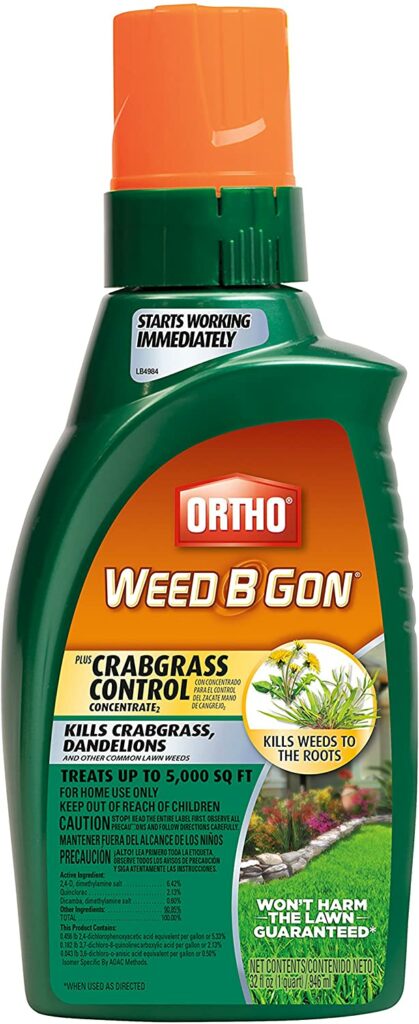
Ortho Weed B Gon Plus Crabgrass Control Concentrate is a post-emergent herbicide that controls about 200 types of weeds, including stubborn ones like dandelions.
Other weeds it successfully controls include:
- Creeping Charlie
- Clover
- Dandelions
- Crabgrass
- Pokeweed
This herbicide contains 2.13% of Quinclorac. A 32 fl. oz. of this herbicide can cover up to 5,000 sq. ft. of your yard. It is a selective herbicide so you can safely use it to filter out the weeds on your lawn and let your desired grass grow well and become lusher green.
The best thing about this herbicide is it works perfectly in controlling the weeds it claims to kill. It is also highly concentrated, so a bottle can last for about a few years of lawn care. It also shows immediate results and is a good option as a spot treating lawn weeds.
The only catch with this herbicide is it is only safe to use on limited types of lawn grass. You can’t use it on the following types of lawn grass:
- Bahiagrass
- Bentgrass (colonial and creeping)
- Carpetgrass
- Centipedegrass
- Dichondra
- Gardens (including vegetables, fruit trees, vines, and berries),
- Ornamental plants (flowers, trees, groundcovers, landscape bed, and shrubs)
- Seashore Paspalum
- St. Augustinegrass
Many gardeners swear by Ortho products, including this herbicide, due to its efficiency and affordability.
Pros
- Rainproof in 1 hour
- Work immediately, see results in 24 hours.
- Affordable
- True to its claims
- Selectively kills weeds
- Best for spot treatments of weeds
Cons
- May cause temporary yellowing or discoloration to bermudagrass
- It may require multiple applications to work on some stubborn weeds.
10. Preen Weed Preventer
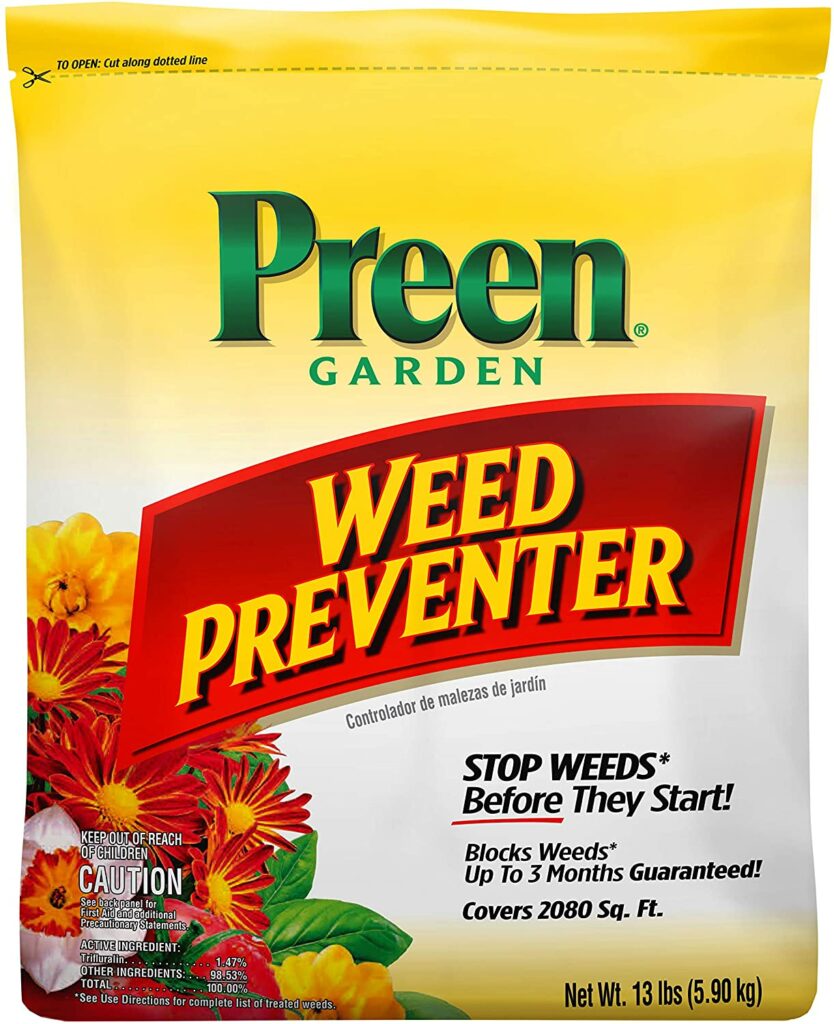
Preen Weed Preventer is a pre-emergent herbicide that uses a different medium than most herbicides in a liquid form. It is ideally applied during spring after spreading mulch on around 200 types of flower beds, vegetables, shrubs, and trees.
This herbicide contains 1.47% Trifluralin (Treflan) which makes it stand out from others. It can also protect your lawn for three months. The manufacturer recommends removing the existing weeds on your lawn before applying this herbicide.
The only concern with this herbicide is it can get washed off whenever it rains or in extreme heat. But overall, it is probably one of the few ones that are safe for use on edibles.
Pros
- Prevents weeds for up to 3 months
- Can be used around over 200 established flowers, vegetables, trees, and shrubs
- Prevents weeds seed from germinating up to 12 weeks per application
- Safe for use on edibles
Cons
- Reapplication may be necessary sooner during periods of heavy rain or excessive heat and humidity; or if you have porous, sandy-type soil.
Tips in Applying Herbicides on Your Lawn
Herbicides are toxic to plants and should be handled with care or else you’ll end up with dead plants.
So, if you’re about to buy an herbicide, here are some of the factors that you should check in finding the product that will suit your needs:
- Type of herbicide: Check if the herbicide is pre-emergent which means that it prevents the weed seeds from germination or post-emergent that gets rid of mature crabgrass.
- Active ingredient: Knowing the active ingredients of the herbicide can help you identify if it is a selective or a non-selective herbicide. The chemicals added to the herbicide will also give away the safety precaution that you need to do during application.
- Selective or non-selective herbicides: Non-selective herbicides will wipe out any plant that it touches. So mistakenly applying it on your turfgrass will cause so much damage. Then, there are selective herbicides that filter out the weeds from the good quality of grass.
- Compatible types of grass for the herbicide: Every herbicide can only be safe to certain kinds of grass. If you apply a herbicide that is not compatible with it will turn it yellow or in worse cases, kill your ideal grass.
- Duration of weed control of pre-emergent herbicides: Every herbicide features its duration of weed protection. Some can protect your lawn for a maximum of 3 months.
- Ideal temperature requirements and other features: Some herbicides will only work if you apply them to their ideal temperature which is usually 50F to 90F. You should also check other features included in every product like being rainproof or longer shelf-life.
Final Thoughts
The best crabgrass killer for your lawn depends on your needs. If you want to control weeds on pathways, you’d get the most benefit from buying a non-selective herbicide. On the other hand, if you want to improve your lawn, selective herbicide would suit you best, either pre-emergent or post-emergent.
Our top picks for the best crabgrass killer are Scotts Halts Weed Preventer; Compare-N-Save; and Preen Weed Preventer. They are budget-friendly and efficient in dealing with weeds that exceed the expectations of other mainstream brands.
We hope that this post has been helpful and informative in your quest in finding a crabgrass killer.
If you enjoyed reading this post, please don’t forget to share it with your friends. Let us know in the comments which crabgrass killer worked best for you.
